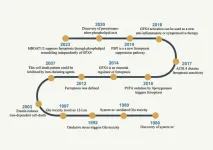In a study publishing December 7, 2023 in JAMA Oncology, UC San Francisco researchers found that regular screening is not always sufficient to prevent an advanced breast cancer diagnosis. To reduce the number of advanced cancer diagnoses, primary prevention is also necessary and should focus on assisting women who are overweight or obese attain normal weight, particularly women of color.
Advanced breast cancer is defined as American Joint Committee on Cancer prognostic pathologic stage II or higher. Advanced breast cancers are tumors that are large and/or have spread to lymph nodes or have other characteristics associated with poorer prognosis such as being high grade and estrogen receptor negative. They require surgery and systemic treatment and detecting breast cancers through screening before they become advanced may avert deaths from breast cancer.
Advanced breast cancer risk calculation for women who are screened regularly can guide screening frequency and supplemental imaging. Clinical risk factors associated with advanced breast cancer include high breast density, high body mass index, increasing age, family history in a first-degree relative with breast cancer, history of previous breast biopsies, and postmenopausal status. Black women have a two-fold higher rate for advanced breast cancer than White women among regular screeners.
To evaluate the population attributable risk proportions (PARPs) for advanced breast cancer – the proportion of advanced cancer incidence in the population attributed to a risk factor – the researchers conducted a cohort study using data collected prospectively from Breast Cancer Surveillance Consortium (BCSC) community-based imaging facilities from January 2005 to June 2018.
The participants followed were 904,615 women aged 40 to 74 (with a median age of 57) undergoing 3,331,740 annual or biennial screening mammograms. Among them, 1815 advanced breast cancers were diagnosed within two years of screening examinations. The risk factors that were examined included heterogeneously or extremely dense breasts, first degree family history of breast cancer, overweight/obesity (body mass index greater than 25), history of benign breast biopsy, and screening interval (biennial versus annual) stratified by menopausal status and race and ethnicity (Asian or Pacific Islander, Black, Hispanic/Latinx, White, other/multiracial).
Body mass index PARPs were larger for post-menopausal than for pre-menopausal women (30% vs 22%) and highest for post-menopausal Black women (38.6%) and Hispanic/Latinx women (31.8%) as well as for pre-menopausal Black women (30.3%). In addition, the overall prevalence of being overweight/obese was highest in pre-menopausal Black (84.4%) and postmenopausal Black (85.1%), and Hispanic/Latinx women (72.4%).
“Black and Hispanic/Latinx women are at higher risk of being diagnosed with advanced cancer than White, Asian, or Pacific Islander women, and this difference is only partially accounted for by screening,” said first author Karla Kerlikowske, MD, UCSF professor of Medicine and Epidemiology & Biostatistics and Co-PI of the BCSC. “Identifying risk factors that account for the largest proportion of advanced breast cancers among regular screeners and understanding the differences in factors associated with risk of advanced cancer by race and ethnicity is important for developing personalized, equitable screening strategies and primary preventions.”
Breast density PARPs were larger for pre-menopausal than for post-menopausal women (37% vs 24%, respectively) and premenopausal White women (39.8%) whose prevalence of dense breasts was high (62%). For both premenopausal and postmenopausal women, PARPs were small for family history of breast cancer (5% to 8%), history of breast biopsy (7% to 12%) and screening interval (2.1% to 2.3%).
Obesity is bigger risk factor than family history in the study
Among routinely screened women, the researchers found that screening frequency was a weak risk factor for advanced cancer and screening biennially vs annually accounted for only a small proportion of advanced cancer diagnoses in this study population. Being overweight or obese accounted for the largest proportion of advanced cancers in postmenopausal women (30%), while dense breasts accounted for the largest proportion of advanced cancers in pre-menopausal women (37%).
“This is the first study, to our knowledge, to calculate PARPs for advanced breast cancer,” said Kerlikowske. “We found that being overweight or obese accounts for the largest proportion of advanced breast cancers among postmenopausal Black and Hispanic/Latinx women. This contrasts with prior studies, reporting that overweight/obesity accounted for the largest proportions of invasive breast cancers for postmenopausal Black women, but not Hispanic /Latinx women.”
Family history of breast cancer accounted for a small proportion of advanced breast cancer in pre-menopausal (8%) and postmenopausal women (5%) in the study. Prior studies have shown that women perceive family history of breast cancer as the primary breast cancer risk factor, with others such as being overweight or obese or having dense breasts, as less important predictors. Kerlikowske adds that patients need to be educated on factors that contribute most to development of advanced breast cancer, and on primary prevention interventions that can modify these risk factors. Offering supplemental imaging with MRI or ultrasonography to women at high advanced cancer risk could also reduce the chance of being diagnosed with advanced cancer.
Additional authors include: Shuai Chen, PhD, Michael C. S. Bissell, PhD, Christoph I. Lee, MD, Jeffrey A. Tice, MD, Brian L. Sprague, PhD, and Diana L. Miglioretti, PhD
Funding: The research was funded by the National Cancer Institute (PO1CA154292 and RO1CA266377).
About UCSF Health: UCSF Health is recognized worldwide for its innovative patient care, reflecting the latest medical knowledge, advanced technologies and pioneering research. It includes the flagship UCSF Medical Center, which is a top-ranked specialty hospital, as well as UCSF Benioff Children’s Hospitals, with campuses in San Francisco and Oakland, Langley Porter Psychiatric Hospital and Clinics, UCSF Benioff Children’s Physicians and the UCSF Faculty Practice. These hospitals serve as the academic medical center of the University of California, San Francisco, which is world-renowned for its graduate-level health sciences education and biomedical research. UCSF Health has affiliations with hospitals and health organizations throughout the Bay Area. Visit https://ucsfhealth.org. Follow UCSF Health on Facebook or on Twitter.
###
Follow UCSF
ucsf.edu | Facebook.com/ucsf | Twitter.com/ucsf | YouTube.com/ucsf
END



